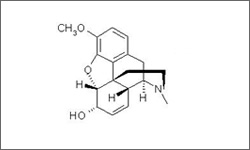Codeine

Codeine is available in several generic forms. It can be given as a tablet, a liquid or an injection, usually several times daily for pain relief. Codeine is also available in several forms in combination with other drugs including Tylenol® with codeine, Soma® with codeine and Floricet® with codeine.
Codeine binds weakly to the mu opioid receptor to relieve pain.
The diagram above shows the 3D molecular structure of Codeine.
Common Side effects include: light-headedness and dizziness, drowsiness, shortness of breath, nausea and vomiting. Constipation may occur with prolonged use. Codeine can be habit-forming, though less so than some other opiate drugs. Psychological and physiological withdrawal symptoms can occur if patient becomes drug-dependent. Alcohol can intensify some of the mental and emotional side effects of codeine, such as drowsiness and changes in mood. Patients should avoid alcohol consumption while taking codeine. At higher doses codeine can cause respiratory depression. This may result in a potentially dangerous slowing of a patient's breathing rate. 1, 2
